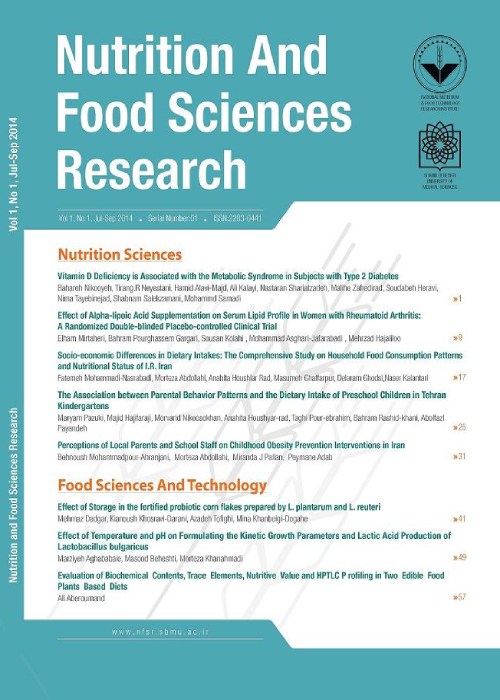Chemical Composition and Biological Activities of Lemon (Citrus limon) Leaf Essential Oil
Author(s):
Abstract:
Background And Objectives
Essential oils and their compounds are getting increasing interest due to their multipurpose functionals as alternatives to the artificial preservatives. The aim of this study was to extract and identify the volatile constituents of essential oil of Citrus lemon leaf and to evaluate its antioxidant and antibacterial abilities.Materials And Methods
The essential oil was extracted using Clevenger apparatus and characterized by means of gas chromatography mass spectrometry (GC-MS). Folin-Ciocalteu method was used to determine the total phenolic equivalent (TPC). The antioxidant properties of the essential oil were evaluated by 2,2- diphenyl-picrylhydrazyl (DPPH) assay and the detection of inhibitory effect of the essential oil at various concentrations (0.025-10 mg/mL) on Staphylococcus aureus, Bacillus cereus, Streptococcus faecium, Escherichia coli, Salmonella typhi and Shigella dysentery was carried out by agar disc-diffusion method and then Minimum Inhibitory Concentration (MIC) assay was evaluated.Results
GC-MS analysis allowed the identification of twenty-seven compounds and linalool (30.62%), geraniol (15.91%), α-terpineol (14.52%), and linalyl acetate (13.76%) were the main constituents. TPC of essential oil was 14.73 mg gallic acid equivalent/g dry plant material and its IC50 value was found to be 0.98 mg/mL in DPPH test, so lemon leaf essential oil showed good free radical scavenging capacity at all studied concentrations. However the antioxidant capacity increased with increasing concentration of the essential oil. The results showed that increasing the essential oil concentration, increases the zone of inhibition, so that the highest antibacterial activity was observed at 10 mg/mL of essential oil. The results of antimicrobial activity by disc diffusion method showed that essential oil exhibited maximum zone inhibition against Gram-positive bacteria including B. cereus, S. aureus and S. faecium, whereas the minimum zone inhibition was shown by S. typhi and S. dysentery as Gram-negative pathogens at the same concentrations. The highest MIC showed by S. aureus and S. dysentery, whereas the least MIC value was observed with B. cereus and S. typhi.Conclusions
The results obtained in this study have shown the moderate biological potential of essential oil of C. limon leaf is probably due to its particular chemical composition, mainly the high amounts of linalool. Therefore, this essential oil could be used to raise the shelf life of foods as a natural preservative ingredient.Keywords:
Antibacterial , Antioxidant , Citrus , Essential oil , GC-MS
Language:
English
Published:
Nutrition & Food Technology Research, Volume:4 Issue: 4, Oct-Dec 2017
Pages:
15 to 24
magiran.com/p1759794
دانلود و مطالعه متن این مقاله با یکی از روشهای زیر امکان پذیر است:
اشتراک شخصی
با عضویت و پرداخت آنلاین حق اشتراک یکساله به مبلغ 1,390,000ريال میتوانید 70 عنوان مطلب دانلود کنید!
اشتراک سازمانی
به کتابخانه دانشگاه یا محل کار خود پیشنهاد کنید تا اشتراک سازمانی این پایگاه را برای دسترسی نامحدود همه کاربران به متن مطالب تهیه نمایند!
توجه!
- حق عضویت دریافتی صرف حمایت از نشریات عضو و نگهداری، تکمیل و توسعه مگیران میشود.
- پرداخت حق اشتراک و دانلود مقالات اجازه بازنشر آن در سایر رسانههای چاپی و دیجیتال را به کاربر نمیدهد.
In order to view content subscription is required
Personal subscription
Subscribe magiran.com for 70 € euros via PayPal and download 70 articles during a year.
Organization subscription
Please contact us to subscribe your university or library for unlimited access!


